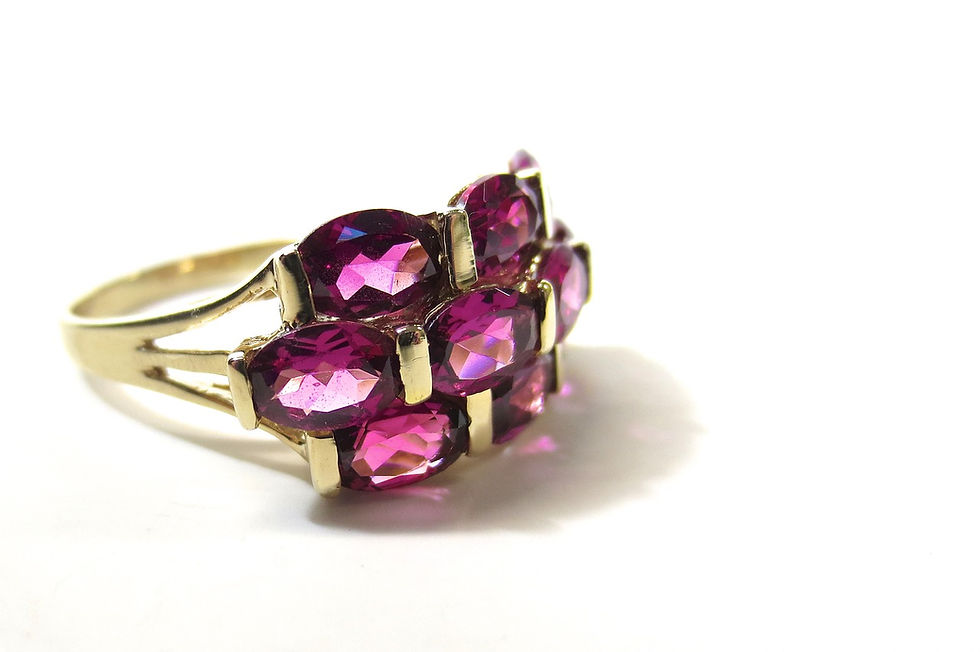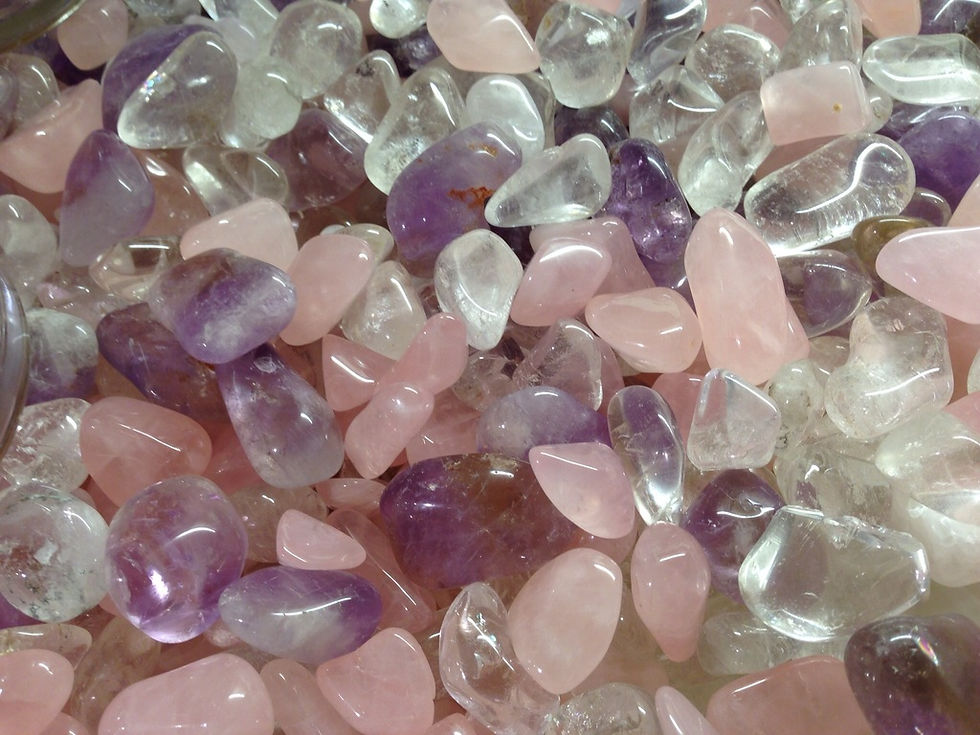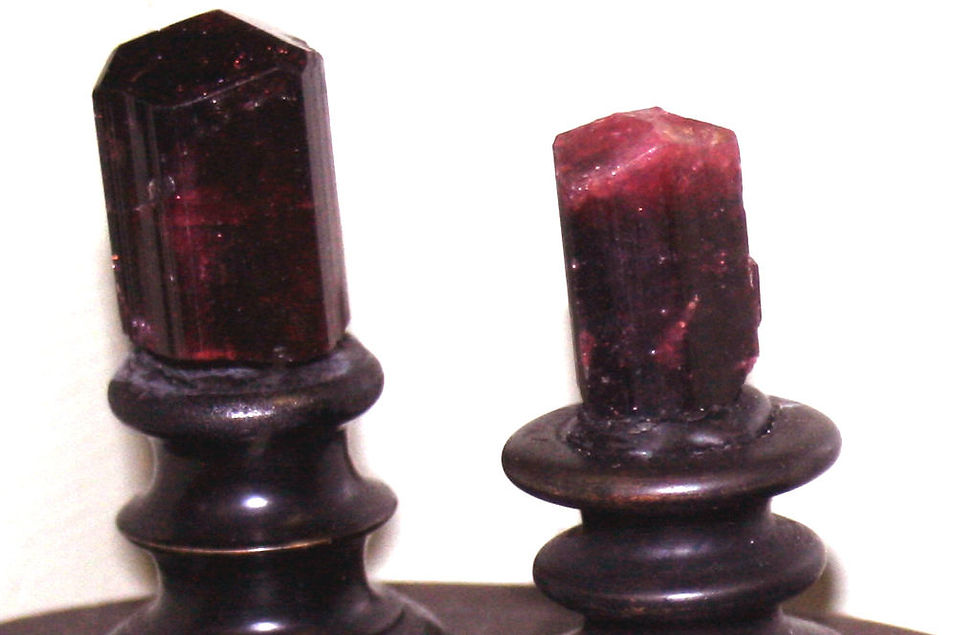Gemology: R is for...
- Alyssum Jewellery
- Aug 14, 2018
- 3 min read
Our 18th journey into the world of gemstones brings you gemstones beginning with R. Take a look at Rhinestone, Rhodochrosite, Rhodolite, Rock Crystal, Rubellite, and Ruby.
Rhinestone
A Rhinestone is an imitation diamond, with the name originally given to rock crystals collected in the Rhine River regions of Germany and Austria. They were popularly used to create 'paste' diamonds for high class jewellery in the 18th and 19th centuries – cheaper than real diamonds but still rather expensive as each crystal had to be hand-cut and faceted to create that diamond sparkle. In the 1720s a metal foil was added to the back of these cut gems to create a more diamond-like fire and radiance. Antique jewellery containing genuine rock crystal rhinestones is quite valuable. In the late 19th century, Swarovski patented a technique to mass produce artificial rhinestones using lead crystal (glass with added lead content), cut on the Swarovski crystal cutting machine – an artificial-artificial diamond, if you will! For the first time Rhinestones, and therefore imitation diamonds, became more widely affordable. Not all rhinestones on the market today come from Swarovski. Swarovski Rhinestones are considered the best, but there are lots of manufacturers creating their own mass-produced rhinestones out of glass, with or without that sparkle-adding lead content. Rhinestones on the market today are cheap and available in a huge range of gemstone colours and cuts.
See our article on Diamond Simulants (link at bottom of page) for more Rhinestone information.
Rhodochrosite
Rhodochrosite is a mineral that, in its pure form, is a rose red colour typically streaked with white. Occasionally impurities can lead to pinkish or even brown-tinged gems. It's quite a soft mineral so jewellery use is generally limited to low impact pieces like necklaces and brooches, and the gems are usually polished en cabochon.
Rhodochrosite is the national gemstone of Argentina, and also goes under the name of Inca Rose.

Rhodolite
Rhodolite is a gemstone in the garnet family, typically with a more pinkish-purple (raspberry) hue than the orange-red we commonly know as the garnet colour. It's often flawless and durable enough for use in jewellery, where it is faceted to show off its brilliance and clarity. It's found in many regions of the earth, and growing in popularity.

Rock Crystal
Rock Crystal is a widely abundant colourless quartz mineral, often used as a decorative piece on its own or faceted as a gemstone for use in jewellery (see Rhinestone above). Coloured variants of quartz include Amethyst, Citrine, Rose Quartz – a cloudy pink colour – and Smoky Quartz.

Rubellite
Rubellite is a variety of tourmaline, occurring in deep reds blended throughout with dark pink, burgundy and brown tones, though brownish tones are least desirable and decrease the value of the gemstone slightly. Rubellite that is predominantly pink is more often referred to simply as pink tourmaline. Almost all Rubellites have 'inclusions', most often in the form of tiny needles seen throughout the gem, and inclusions are considered acceptable. Rubellite is relatively durable and can be faceted for jewellery use.

Ruby
Ruby is one of the Big 4 'precious gems', the others being Sapphire, Diamond and Emerald, and genuine rubies are amongst the most expensive and valuable gemstones you can buy. Rubies are a red form of the mineral corundum, with all other colours and forms of corundum being called Sapphire - rubies are actually red sapphires! In some instances where the colour is not deep or red enough, these red corundums will be marketed as Pink Sapphires rather than as rubies, though this is a relatively new term and distinction.
The more blood-like the red, the more valuable the ruby. All rubies have inclusions, called rutiles, with some inclusions forming a star radiating from the centre of the gem. Rubies displaying this kind of inclusion are called 'Star Rubies'. Rubies are often subjected to treatments to enhance their colour or decrease the appearance of inclusions, and there has been great success in creating rubies in laboratories. Many of the rubies sold at high street jewellers are lab created and not naturally mined. Natural rubies are far more expensive and valuable. Check with your jeweller before purchasing if the distinction is important to you. Ruby is the birthstone for July.

Next week: "Earrings Styles of the 1940s" A look at the glamorous earrings worn in the Roaring Forties!






























Comments